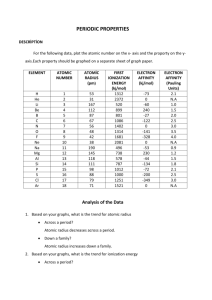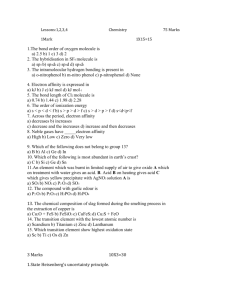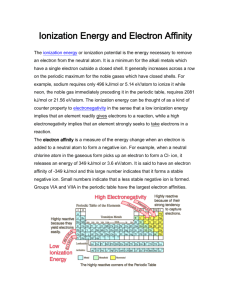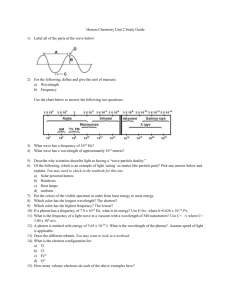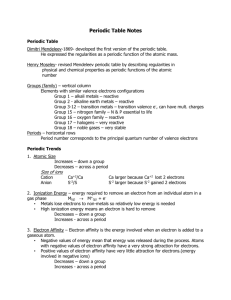Periodic trends: Electron affinity answers. Name 1. What is the
advertisement
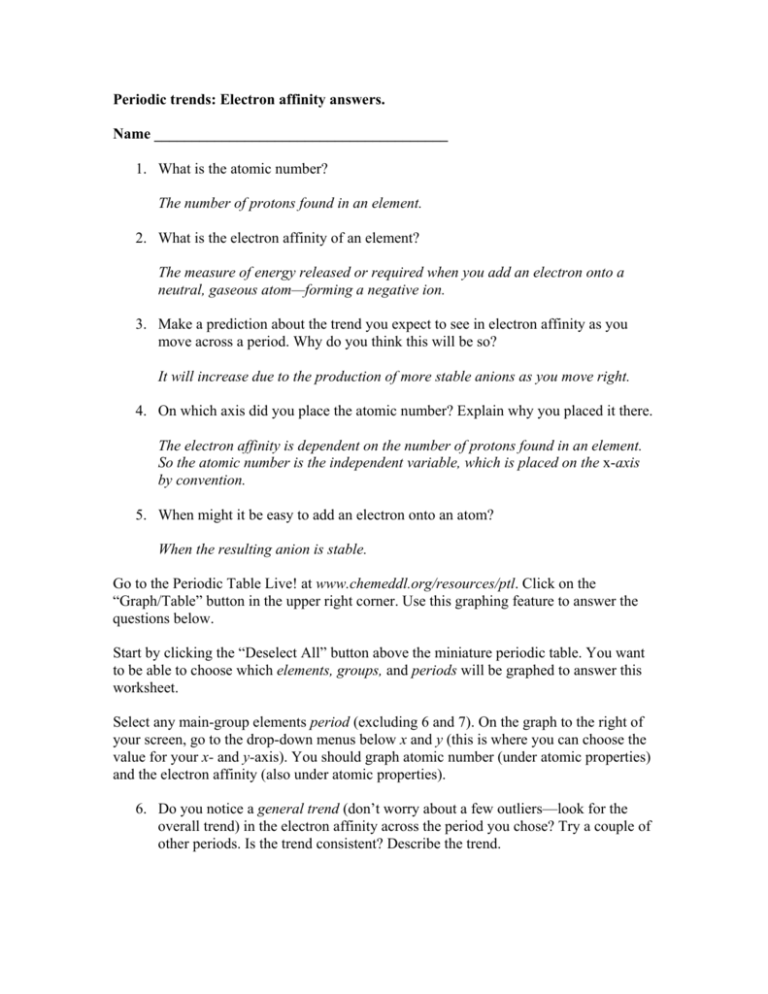
Periodic trends: Electron affinity answers. Name _______________________________________ 1. What is the atomic number? The number of protons found in an element. 2. What is the electron affinity of an element? The measure of energy released or required when you add an electron onto a neutral, gaseous atom—forming a negative ion. 3. Make a prediction about the trend you expect to see in electron affinity as you move across a period. Why do you think this will be so? It will increase due to the production of more stable anions as you move right. 4. On which axis did you place the atomic number? Explain why you placed it there. The electron affinity is dependent on the number of protons found in an element. So the atomic number is the independent variable, which is placed on the x-axis by convention. 5. When might it be easy to add an electron onto an atom? When the resulting anion is stable. Go to the Periodic Table Live! at www.chemeddl.org/resources/ptl. Click on the “Graph/Table” button in the upper right corner. Use this graphing feature to answer the questions below. Start by clicking the “Deselect All” button above the miniature periodic table. You want to be able to choose which elements, groups, and periods will be graphed to answer this worksheet. Select any main-group elements period (excluding 6 and 7). On the graph to the right of your screen, go to the drop-down menus below x and y (this is where you can choose the value for your x- and y-axis). You should graph atomic number (under atomic properties) and the electron affinity (also under atomic properties). 6. Do you notice a general trend (don’t worry about a few outliers—look for the overall trend) in the electron affinity across the period you chose? Try a couple of other periods. Is the trend consistent? Describe the trend. It’s a fairly consistent upward trend, but there are a reasonable number of outliers. More energy is released as you move across the periodic table because you from more stable anions. 7. Can you explain why you see this trend as you move across a period? A larger positive charge results from the increase in protons in the nucleus. This larger positive charge will generally attract the electrons better and make the resulting anions more stable. Electron configuration becomes more stable with added electrons as you move farther to the right. 8. Make a prediction about what trend you expect to see in electron affinity as you move down the periodic table. Explain your prediction. I expect the electron affinity to decrease as I move down a group. Even though the nuclear charge increases as I move down the periodic table, electrons are being placed into shells that are farther from the nucleus, negating the effect of that charge. 9. Test your prediction: Deselect all and choose any one group in the periodic table and the same x- and y-axes. Look at a few more groups. Do you see a trend in the electron affinity down a group? Is it consistent between groups? Does it agree with your prediction? It’s pretty random. In some groups it goes down, which is consistent with my prediction. In others, it goes up. In some, it goes up and then down. 10. Can you explain why you see this result? My prediction above is based on nuclear charge and electron shells getting farther away from the nucleus. These are not the only factors affecting electron affinities, so the trend is less concrete and predictable as I move down a group (or even across a period). For a more thorough exploration of electron affinity, download the following article: Wheeler, J.C. 1997. Electron affinities of the alkaline Earth metals and the sign convention for electron affinity. Journal of Chemical Education 74 (1): 123–127.

